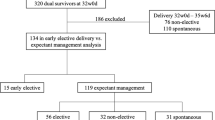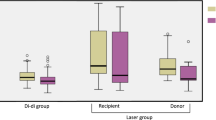Abstract
Objective
To compare short-term and long-term outcomes of preterm infants born at <29 weeks of gestational age (GA) with twin–twin transfusion syndrome (TTTS) treated with laser therapy to preterm twin infants without TTTS.
Design
Retrospective case–control study comparing 33 preterm TTTS twins to 101 preterm diamniotic–dichorionic (di–di) twins born at our institution between 2006 and 2015.
Results
GA at birth were 26.4 ± 1.4 weeks (TTTS) and 26.9 ± 1.6 weeks (di–di) (p = 0.07). TTTS premature newborns were less exposed to antenatal steroids (p = 0.01), more frequently born by C-section (p = 0.005), received more surfactant therapy (p = 0.004, and were smaller for GA (p < 0.001). When adjusted for antenatal steroids and birth weight, TTTS status was not associated with increased mortality (HR 1.66, 95% CI 0.77–3.56, p = 0.20). No differences were found on neurodevelopmental outcomes at 18 months of corrected GA.
Conclusion
Premature TTTS newborns treated with fetal laser therapy had similar survival and neurodevelopmental outcomes compared to preterm di–di twins without TTTS.
This is a preview of subscription content, access via your institution
Access options
Subscribe to this journal
Receive 12 print issues and online access
$259.00 per year
only $21.58 per issue
Buy this article
- Purchase on Springer Link
- Instant access to full article PDF
Prices may be subject to local taxes which are calculated during checkout

Similar content being viewed by others
References
Harkness UF, Crombleholme TM. Twin-twin transfusion syndrome: where do we go from here? Semin Perinatol. 2005;29:296–304.
Li X, Morokuma S, Fukushima K, Otera Y, Yumoto Y, Tsukimori K, et al. Prognosis and long-term neurodevelopmental outcome in conservatively treated twin-to-twin transfusion syndrome. BMC Pregnancy Childbirth. 2011;11:32.
Van Mieghem T, Lewi L, Gucciardo L, Dekoninck P, Van Schoubroeck D, Devlieger R, et al. The fetal heart in twin-to-twin transfusion syndrome. Int J Pediatr. 2010;2010:379792.
Pruetz JD, Sklansky M, Detterich J, Korst LM, Llanes A, Chmait RH. Twin-twin transfusion syndrome treated with laser surgery: postnatal prevalence of congenital heart disease in surviving recipients and donors. Prenat Diagn. 2011;31:973–7.
Wee LY, Fisk NM. The twin-twin transfusion syndrome. Semin Neonatol. 2002;7:187–202.
Quarello E, Molho M, Ville Y. Incidence, mechanisms, and patterns of fetal cerebral lesions in twin-to-twin transfusion syndrome. J Matern Fetal Neonatal Med. 2007;20:589–97.
De Lia JE, Cruikshank DP, Keye WR Jr. Fetoscopic neodymium: YAG laser occlusion of placental vessels in severe twin-twin transfusion syndrome. Obstet Gynecol. 1990;75:1046–53.
Senat MV, Deprest J, Boulvain M, Paupe A, Winer N, Ville Y. Endoscopic laser surgery versus serial amnioreduction for severe twin-to-twin transfusion syndrome. N Engl J Med. 2004;351:136–44.
Diehl W, Diemert A, Hecher K. Twin-twin transfusion syndrome: treatment and outcome. Best Pract Res Clin Obstet Gynaecol. 2014;28:227–38.
Roberts D, Neilson JP, Kilby MD, Gates S. Interventions for the treatment of twin-twin transfusion syndrome. Cochrane Database Syst Rev. 2014;CD002073.
Delabaere A, Leduc F, Reboul Q, Fuchs F, Wavrant S, Fouron JC, et al. Prediction of neonatal outcome of TTTS by fetal heart and Doppler ultrasound parameters before and after laser treatment. Prenat Diagn. 2016;36:1199–205.
Papanna R, Mann LK, Baschat AA, Bebbington MW, Khalek N, Johnson A, et al. Cervical length in prediction of preterm birth after laser surgery for twin-twin transfusion syndrome. Ultrasound Obstet Gynecol. 2015;45:175–82.
Bodeau-Livinec F, Zeitlin J, Blondel B, Arnaud C, Fresson J, Burguet A, et al. Do very preterm twins and singletons differ in their neurodevelopment at 5 years of age? Arch Dis Child Fetal Neonatal Ed. 2013;98:F480–7.
Fumagalli M, Schiavolin P, Bassi L, Groppo M, Uccella S, De Carli A, et al. The impact of twin birth on early neonatal outcomes. Am J Perinatol. 2016;33:63–70.
Coutinho Nunes F, Domingues AP, Vide Tavares M, Belo A, Ferreira C, Fonseca E, et al. Monochorionic versus dichorionic twins: are obstetric outcomes always different? J Obstet Gynaecol. 2016;36:598–601.
Society for Maternal-Fetal Medicine, Simpson LL. Twin-twin transfusion syndrome. Am J Obstet Gynecol. 2013;208:3–18.
Quintero RA, Morales WJ, Allen MH, Bornick PW, Johnson PK, Kruger M. Staging of twin-twin transfusion syndrome. J Perinatol. 1999;19(8 Pt 1):550–5.
Merhar SL, Kline-Fath BM, Meinzen-Derr J, Schibler KR, Leach JL. Fetal and postnatal brain MRI in premature infants with twin-twin transfusion syndrome. J Perinatol. 2013;33:112–8.
Albers CA, Grieve AJ. Test Review: Bayley, N. (2006). Bayley Scales of Infant and Toddler Development–Third Edition. San Antonio, TX: Harcourt Assessment. J Psychoeduc Assess. 2007;25:180–90.
Soraisham AS, Singhal N, McMillan DD, Sauve RS, Lee SK. A multicenter study on the clinical outcome of chorioamnionitis in preterm infants. Am J Obstet Gynecol. 2009;200:372.e1–6.
Kramer MS, Platt RW, Wen SW, Joseph KS, Allen A, Abrahamowicz M, et al. A new and improved population-based Canadian reference for birth weight for gestational age. Pediatrics. 2001;108:E35.
Jobe AH, Bancalari E. Bronchopulmonary dysplasia. Am J Respir Crit Care Med. 2001;163:1723–9.
Bell MJ, Ternberg JL, Feigin RD, Keating JP, Marshall R, Barton L, et al. Neonatal necrotizing enterocolitis. Therapeutic decisions based upon clinical staging. Ann Surg. 1978;187:1.
Papile LA, Burstein J, Burstein R, Koffler H. Incidence and evolution of subependymal and intraventricular hemorrhage: a study of infants with birth weights less than 1,500 gm. J Pediatr. 1978;92:529–34.
Bricelj K, Tul N, Lasic M, Bregar AT, Verdenik I, Lucovnik M, et al. Respiratory morbidity in twins by birth order, gestational age and mode of delivery. J Perinat Med. 2016;44:899–902.
Sharma P, McKay K, Rosenkrantz TS, Hussain N. Comparisons of mortality and pre-discharge respiratory outcomes in small-for-gestational-age and appropriate-for-gestational-age premature infants. BMC Pediatr. 2004;4:9.
Lewi L, Gucciardo L, Huber A, Jani J, Van Mieghem T, Done E, et al. Clinical outcome and placental characteristics of monochorionic diamniotic twin pairs with early- and late-onset discordant growth. Am J Obstet Gynecol. 2008;199:511.e1–7.
Van Winden KR, Quintero RA, Kontopoulos EV, Korst LM, Llanes A, Chmait RH. Perinatal survival in cases of twin-twin transfusion syndrome complicated by selective intrauterine growth restriction. J Matern Fetal Neonatal Med. 2015;28:1549–53.
Reiss I, Landmann E, Heckmann M, Misselwitz B, Gortner L. Increased risk of bronchopulmonary dysplasia and increased mortality in very preterm infants being small for gestational age. Arch Gynecol Obstet. 2003;269:40–4.
Lee HC, Green C, Hintz SR, Tyson JE, Parikh NA, Langer J, et al. Prediction of death for extremely premature infants in a population-based cohort. Pediatrics. 2010;126:e644–50.
Denbow ML, Battin MR, Cowan F, Azzopardi D, Edwards AD, Fisk NM. Neonatal cranial ultrasonographic findings in preterm twins complicated by severe fetofetal transfusion syndrome. Am J Obstet Gynecol. 1998;178:479–83.
Lopriore E, van Wezel-Meijler G, Middeldorp JM, Sueters M, Vandenbussche FP, Walther FJ. Incidence, origin, and character of cerebral injury in twin-to-twin transfusion syndrome treated with fetoscopic laser surgery. Am J Obstet Gynecol. 2006;194:1215–20.
Graef C, Ellenrieder B, Hecher K, Hackeloer BJ, Huber A, Bartmann P. Long-term neurodevelopmental outcome of 167 children after intrauterine laser treatment for severe twin-twin transfusion syndrome. Am J Obstet Gynecol. 2006;194:303–8.
Sutcliffe AG, Sebire NJ, Pigott AJ, Taylor B, Edwards PR, Nicolaides KH. Outcome for children born after in utero laser ablation therapy for severe twin-to-twin transfusion syndrome. BJOG. 2001;108:1246–50.
van Klink JM, Slaghekke F, Balestriero MA, Scelsa B, Introvini P, Rustico M, et al. Neurodevelopmental outcome at 2 years in twin-twin transfusion syndrome survivors randomized for the Solomon trial. Am J Obstet Gynecol. 2016;214:113.e1–7.
Maschke C, Diemert A, Hecher K, Bartmann P. Long-term outcome after intrauterine laser treatment for twin-twin transfusion syndrome. Prenat Diagn. 2011;31:647–53.
Lopriore E, Ortibus E, Acosta-Rojas R, Le Cessie S, Middeldorp JM, Oepkes D, et al. Risk factors for neurodevelopment impairment in twin-twin transfusion syndrome treated with fetoscopic laser surgery. Obstet Gynecol. 2009;113(2 Pt 1):361–6.
Author information
Authors and Affiliations
Corresponding author
Ethics declarations
Conflict of interest
The authors declare that they have no conflict of interest.
Rights and permissions
About this article
Cite this article
Sommer, J., Nuyt, AM., Audibert, F. et al. Outcomes of extremely premature infants with twin–twin transfusion syndrome treated by laser therapy. J Perinatol 38, 1548–1555 (2018). https://doi.org/10.1038/s41372-018-0202-z
Received:
Revised:
Accepted:
Published:
Issue Date:
DOI: https://doi.org/10.1038/s41372-018-0202-z
This article is cited by
-
Developmental outcomes for survivors of placental laser photocoagulation for the management of twin-to-twin transfusion syndrome
BMC Pregnancy and Childbirth (2023)
-
Chorionicity and neurodevelopmental outcomes in twin pregnancy: a systematic review and meta-analysis
Journal of Perinatology (2023)
-
Renal functional markers in extremely premature infants with and without twin–twin transfusion syndrome
Journal of Perinatology (2020)



